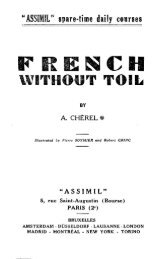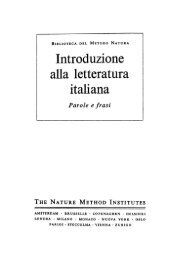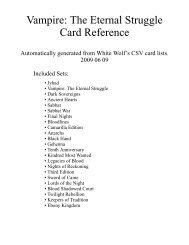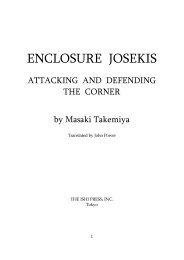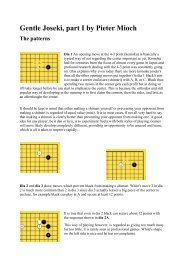Plains Cree: A Grammatical Study - Computer Science Club
Plains Cree: A Grammatical Study - Computer Science Club
Plains Cree: A Grammatical Study - Computer Science Club
Create successful ePaper yourself
Turn your PDF publications into a flip-book with our unique Google optimized e-Paper software.
ekwa kawisimowak.<br />
then go to bed(AI 3p)<br />
'When he knew the other to be sleepy, then they<br />
went to bed.'<br />
P 98-40 wdpam esi-miyosicik<br />
see(TA 2-3p) be so beautiful(AI 3p)<br />
nisim ohi iskwewah.<br />
my brother(3) this(3') woman(3')<br />
'Look how beautiful are my brother and this<br />
woman.'<br />
T124-3 nete tahkohc-dyihk e-otihtdt<br />
there at the top reach(TA 3-(3'))<br />
kiyomdndkosiwak;<br />
be in full sight(AI 3p)<br />
'when he reached them at the top there, they<br />
(including him) were in full sight.'<br />
Another example involves a pronominal predication:<br />
T 10p91 tdniwd etokwe<br />
where is she(3) I wonder<br />
omamdwawa.<br />
their (3p) mother (3')<br />
'Where is she, I wonder, their mother?'<br />
Thus the non-obviative category, being unmarked,<br />
has a wide and a narrow function and meaning. We<br />
use the term "proximate" only of the narrow meaning,<br />
where it is opposed to "obviative." For the wide<br />
meaning, the term "third person" is obviously appro-<br />
priate. These terminological conventions may be<br />
diagrammed as follows:<br />
"proximate"<br />
"third person"<br />
WOLFART: PLAINS CREE<br />
20 [TRANS. AMER. PHIL. SOC.<br />
"obviative"<br />
obviative<br />
It is interesting that the present analysis in terms<br />
of marked and unmarked members of an opposition<br />
is in fact inherent in the system of abbreviations used<br />
by many Algonquianists. (In practice, the tradi-<br />
tional definitions of the abbreviations differ; "3" is<br />
normally used only in its narrow meaning, 'proxi-<br />
mate.')27<br />
a7 The present analysis finds striking support in the Blackfoot<br />
situation where in addition to noun-forms marked for different<br />
2.24. "Further Obviative"<br />
Most recent studies of <strong>Cree</strong> grammar assume a<br />
further binary opposition within the obviative cate-<br />
gory, resulting in a "nearer" and a "farther" (Bloom-<br />
field) or "further" (Hockett) obviative. Such a<br />
system may well be historically justified for <strong>Cree</strong>.<br />
Synchronically, however, there is strong evidence to<br />
suggest that this further distinction is spurious.<br />
The only point in <strong>Cree</strong> grammar where such a<br />
further distinction would be expressed is in the third-<br />
person forms of the transitive animate (TA) paradigm.<br />
The reasons which presumably led to the received<br />
analysis are explored in 5.631. One of its more salient<br />
weaknesses is that it would skew the TA verb paradigm<br />
and require an inordinate amount of paradigmatic<br />
mergings.<br />
In an argument (5.63) based on the overall struc-<br />
ture of the TA verb paradigm and on the nature of<br />
the proximate-obviative opposition we attempt to<br />
show that the present interpretation more adequately<br />
portrays the facts of <strong>Cree</strong>.<br />
Certainly no evidence for such a distinction is found<br />
in the inflection of nouns and pronouns.2<br />
Thus, Hockett's description (1966) of the total<br />
system of person indexing in the central Algonquian<br />
languages is too wide for <strong>Cree</strong>. While it may well fit<br />
the referential system of <strong>Cree</strong>, it over-accounts for<br />
the morphological and significative patterns. Need-<br />
less to say, of course, Hockett's system is easily<br />
adjusted to account for the <strong>Cree</strong> situation as viewed<br />
here.29<br />
2.3. GENDER<br />
There are two gender categories, animate and<br />
inanimate. The gender contrast is manifest through-<br />
out the inflection of nouns, pronouns, and verbs.<br />
Although the evidence is inconclusive, the gender<br />
contrast is possibly neutralized in the identity of<br />
obviation categories (symbolized as 3, 4, and 5) there is a non-<br />
indexed, i.e., general form as well. "This non-indexed form is<br />
not hypothetical but the 'name' of an item in a context where<br />
person indexing is not relevant, such as in response to the ques-<br />
tion, "What is the word for __? . . ." (Frantz, 1966: p. 51).<br />
Thus, the non-indexed form for 'man' is nina, the proximate,<br />
ninaoa, and the first obviative, ninai.<br />
28 This is in striking contrast with the situation in Potawatomi,<br />
for example, where Hockett (1948: p. 72) describes the obviative<br />
marker/n/ as occurring twice in succession; e.g., mt'uk 'tree' (3),<br />
mt'ukwen 'tree(s)' (3'), and mt'ukwenun 'tree(s)' (3"). How-<br />
ever, Hockett himself (1966: p. 64) calls the 3" forms "extremely<br />
rare" and says they are "perhaps avoided as 'awkward.'"<br />
Rogers (1963: p. 103) reports the same situation in Northern<br />
Ojibwa, but without examples or further details. While Bloom-<br />
field (1946: p. 94) asserts the distinction with reference to <strong>Cree</strong>,<br />
no mention of it was found in his descriptions of Menomini, Fox,<br />
or Eastern Ojibwa.<br />
29 In terms of Hockett's diagram (fig. 1; 1966: p. 60), only the<br />
"further obviative" node needs to be deleted. If the line leading<br />
to it is left to peter out, pointing to no specific node, this might<br />
provide a graphic conceptualization of the open-endedness of the<br />
<strong>Cree</strong> situation.



